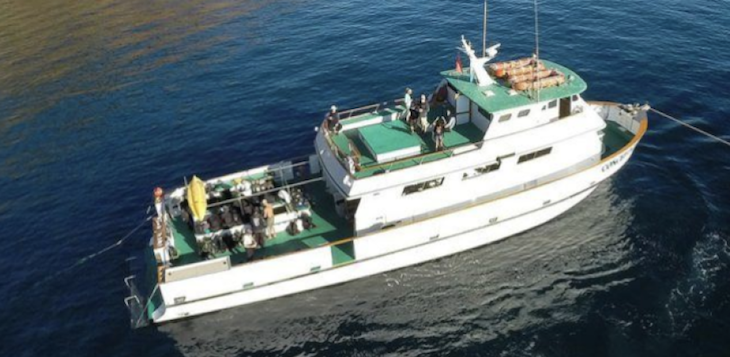By the edhat staff
In a confidential report reviewed by The Los Angeles Times, it has been revealed that the tragic fire that took the lives of 34 people aboard the Conception dive boat four years ago was started in a plastic trash can on the main deck.
A team of investigators from the bureau of Alcohol, Tobacco, Firearms and Explosives (ATF) conducted extensive tests to determine the origin and cause of the blaze, ultimately concluding that it began in the trash container and rapidly spread throughout the vessel.
The findings shed new light on the deadliest maritime disaster in modern California history, adding to the mystery surrounding its cause. However, due to ongoing criminal and civil court proceedings related to the incident, the report has not been publicly disclosed.
The fire broke out in the early hours of September 2, 2019, while the 75-foot wooden-hulled Conception was anchored off Santa Cruz Island. As the flames engulfed the boat, five crew members who were asleep in the wheelhouse were awakened by shouts of “Fire! Fire!” Shortly after 3 a.m., the boat’s 33 passengers and another crew member found themselves trapped below deck. Disturbing cellphone footage captured their desperate attempts to escape before the crew members jumped overboard and sought help from a neighboring boat.
Initial investigations by the National Transportation Safety Board (NTSB) focused on the charging areas where divers plugged in lithium-ion batteries. One crew member suspected that the phone-charging station might have sparked the fire. However, ATF investigators honed in on a 23-gallon Rubbermaid Slim Jim garbage bin located under the main deck stairs as the point of origin.
The report, authored by ATF Special Agent Derek J. Hill in January 2021, outlined the meticulous examination of the fire scene, witness statements, pre-fire and fire photographs, and conducted test fires. The investigators concluded that the fire originated in the garbage container under the staircase.
Captain Jerry Boylan, who was in charge of the Conception, has been charged with 34 counts of manslaughter for allegedly failing to use a roving watch commander while the passengers were sleeping, as required by Coast Guard regulations. Boylan, who denies any wrongdoing, is scheduled to be tried in federal court next month.

Plaque honoring the victims (edhat file photo)
The ATF’s comprehensive investigation included multiple re-creations of the fire, which showed that a wall of flames quickly engulfed the Conception, blocking all escape routes within minutes. The report also highlighted the danger posed by highly combustible polyethylene trash cans made by Rubbermaid, which were present throughout the vessel.
Despite determining the point of origin, investigators have yet to identify the ignition source. The ATF stated that the cause remains “undetermined” and could be attributed to discarded smoking material, the open flame ignition of combustible materials, or an event unknown to investigators.
The 197-page report noted that Boylan smoked cigarettes, but he said he threw them overboard. There was a birthday celebration that used candles but survivors stated they were all extinguished. The report also notes that two crew members tested positive for marijuana but denied smoking onboard.
Another crew member stated he emptied four smaller trash bins into the 23-gallon receptacle about 2:35 a.m. the night of the fire. He was awakened about 3:12 a.m. by a popping sound and saw a glow from the middle deck.
The tragic fire prompted the Coast Guard to implement stricter standards on charging stations aboard vessels, and a critical safety alert was issued to passenger vessel operators warning against the use of such garbage cans.
Nevertheless, the families of the victims continue to seek justice, with some filing lawsuits against the owner of Truth Aquatics, the dive boat company, as well as against the U.S. Coast Guard for alleged negligence.
As the investigation continues, the ATF’s report provides crucial insight into the events leading to the deadly Conception boat fire, highlighting the need for enhanced safety measures and regulations to prevent such tragedies from occurring in the future.
MORE ARTICLES




 All Conception Boat Fire Related Articles
All Conception Boat Fire Related Articles

